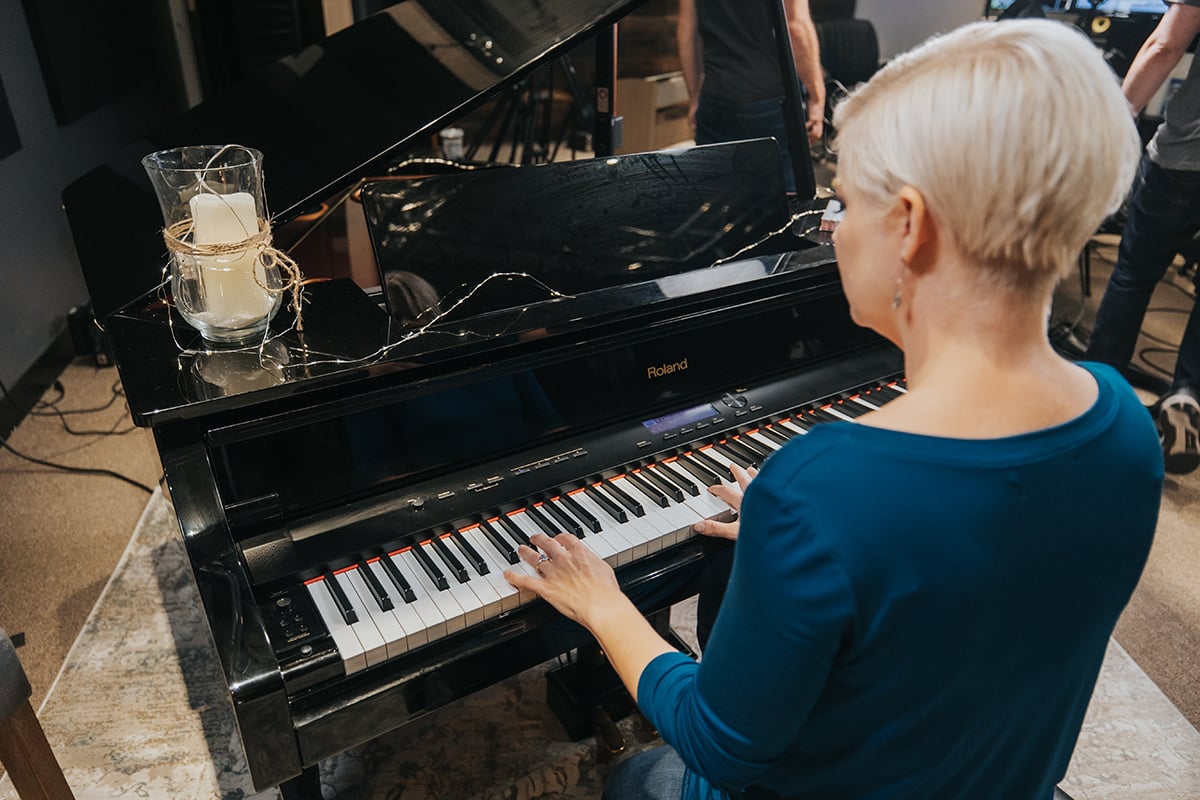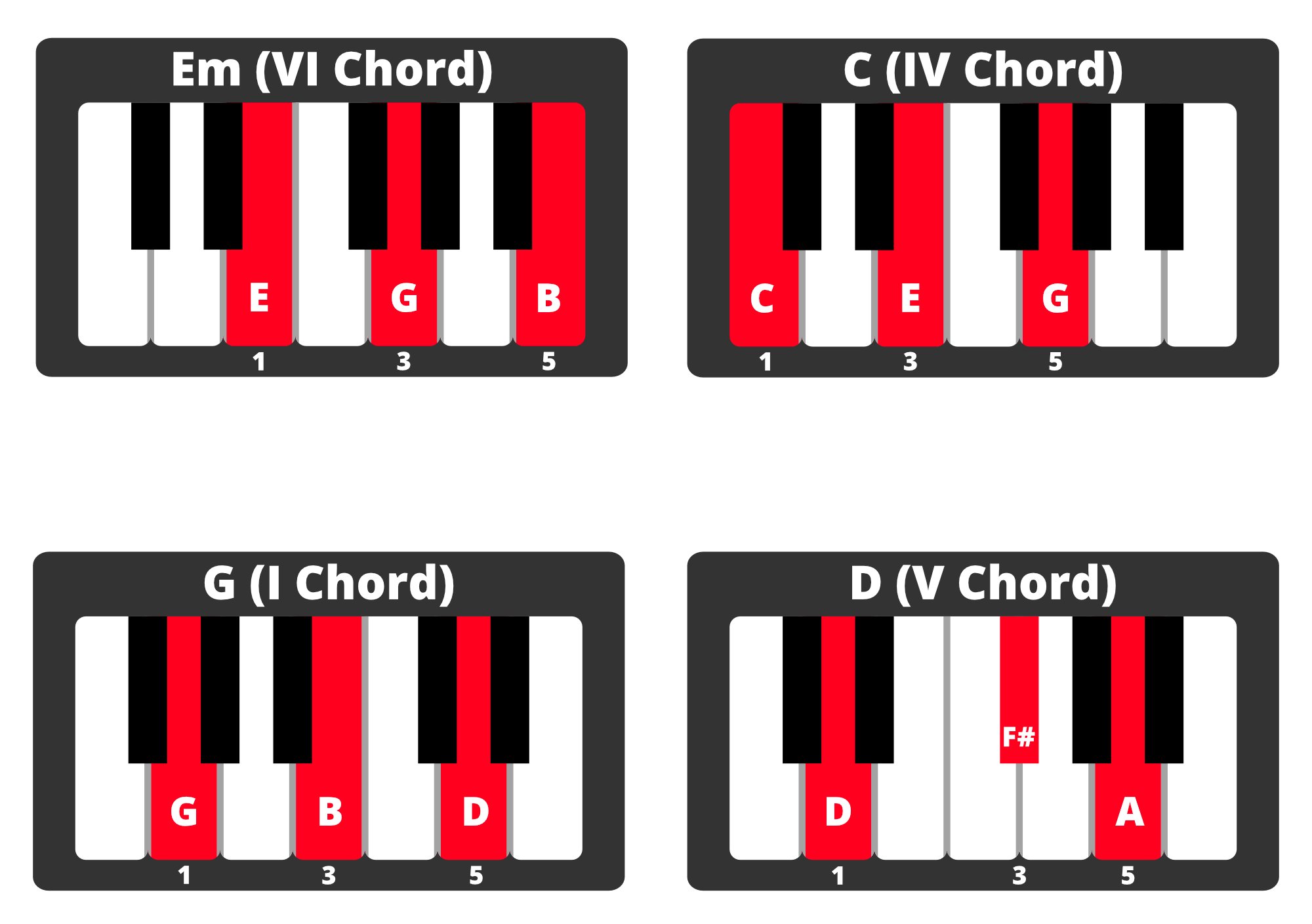Left-hand sluggishness on the piano is quite common. Makes sense, since most of us are right-handed.
Today, I’ll share my top 3 awesome and challenging left-hand piano exercises with you! These drills will target and strengthen the weaker fingers of your left hand (ring and pinky fingers—we’re looking at you!), help you move more efficiently between notes, and get you playing a left-hand chord progression that uses common chords.

For many people, our left hands are weaker. And while the right hand typically carries the melody on the piano, piano wouldn’t be the same without the left hand providing beautiful arpeggios and accompaniment patterns. Your left hand deserves more love, so check out the De-stupefy Your Left Hand course to give it the attention it needs! Free with your Pianote membership.
CHECK IT OUTIn this exercise, we’ll play all the intervals of the G major scale solid (together) and broken (apart).
Before we start, let’s review the notes of the G major scale— these will be our “ingredients” for this exercise:
G Major Scale:
G-A-B-C-D-E-F#-G
Place your hand in the G position: finger 5 on the left-hand goes on G, finger 4 goes on A, and so on.
To play the solid form of this exercise, play G and A together four times, then G and B together four times, and so on, moving through the intervals.
When you get to the sixth interval (G-E), bump up your thumb.
You can play the octave notes separately if you have small hands. If you’re having trouble reaching an octave, try playing at the ends of the keys.
Now, this exercise might not sound as musical, but it’ll definitely strengthen the fourth and fifth left-hand fingers.
Next, try the same exercise broken. This means playing the notes separately, like this:
Once you’re comfortable with the pattern, ramp up the speed!
Try this drill in other keys too, like C major or F major.
Fingers 4 and 5 have a tendency to stick together. This exercise will train you to un-stick them!
We’ll play a pattern up the keyboard that looks like this:
Let’s start on C. Place your left hand in the C position and play:
Notes:
C-D-C-D-C-D-A-G-F-E-D
Fingering (Left Hand):
5-4-5-4-1-2-3-4-5
You’ll land in the D position and keep going:
Notes:
D-E-D-E-D-E-B-A-G-F-E
Fingering (Left hand):
5-4-5-4-1-2-3-4-5
Which will land you in the E position, and so on.
Your left pinky may fly up due to tension. This is common— don’t stress! Just try to stay present and relaxed.
Once this exercise feels comfortable, switch it up! Vary your fingering and your notes— try 3-5-4-2-1— and challenge yourself to play fast!
Finally, let’s put our left hand to work with a chord progression. This one is fun because it sounds like a song. 🙌
We’ll be using this G major chord progression: vi-IV-I-V.
Chord Progression Exercise
Key: G Major (1 sharp = F#)
Chord Progression: vi-IV-I-V
Chords: Em-C-G-D
🔥🎹 Hot Tip: We have tons of free resources, like this one, that explain chord progressions in detail and the numbering system.
We’ll play these chords in our left hand, broken, using a chord shape built on the first and fifth notes of the G major scale. Like this:
The notes and fingering look like this:

Sidenote: The number in “C4” and “G3” refers to which octave the note belongs in.
Here’s the ‘E minor’ chord note by note:
Once you have this pattern down, bring your right hand to the party by playing the same chord in root position.
Em (vi chord)
Notes: E-G-B
Fingering (Right Hand): 1-3-5
C (IV chord)
Notes: C-E-G
Fingering: 1-3-5
G (I chord)
Notes: G-B-D
Fingering: 1-3-5
D (V chord)
Notes: D-F#-A
Fingering: 1-3-5
Next, try playing individual notes of the chord and mixing up the order of notes.
Then, get creative, break the rules, and add some original melodies! Try these left-hand piano exercises in a lower octave and you can sound dark and intense. Fun fact: In guitar, this chord shape (octave + fifth) is called the power chord— so use them to inject some power into your music!
Lisa Witt has been teaching piano for more than 20 years and in that time has helped hundreds of students learn to play the songs they love. Lisa received classical piano training through the Royal Conservatory of Music, but she has since embraced popular music and playing by ear in order to accompany herself and others. Learn more about Lisa.


By signing up you’ll also receive our ongoing free lessons and special offers. Don’t worry, we value your privacy and you can unsubscribe at any time.
We use cookies for traffic data and advertising. Cookie Policy »